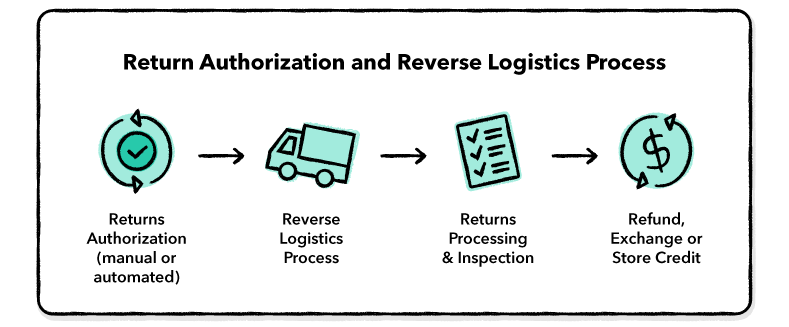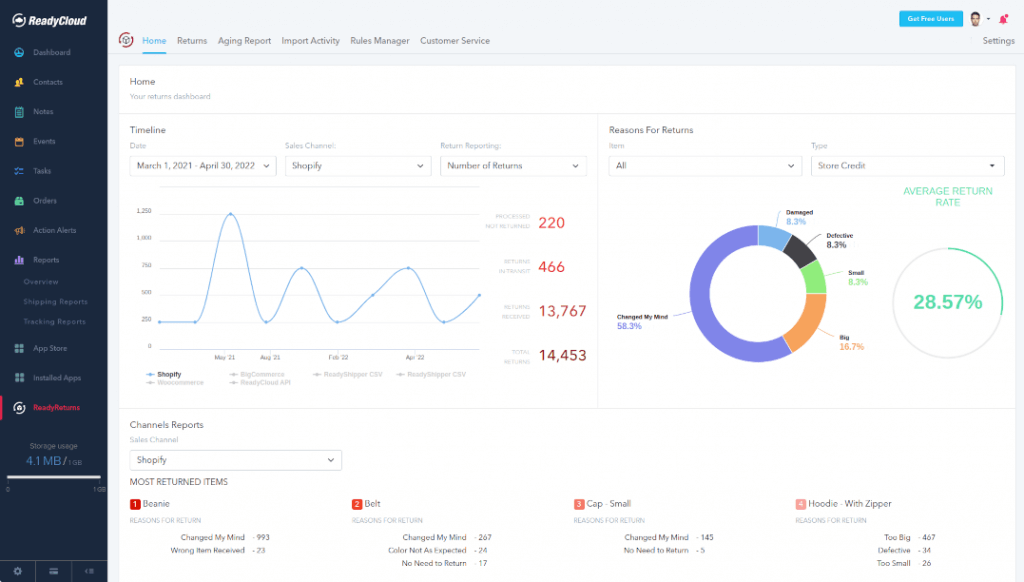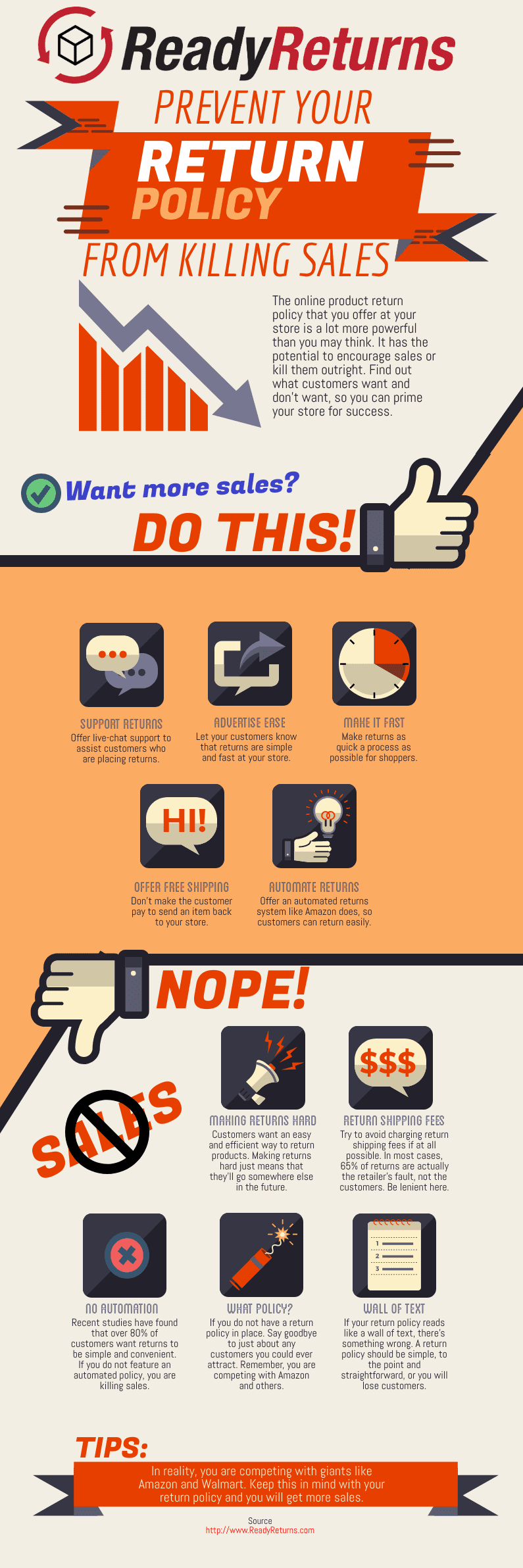Managing Returns on Shopify: The Only Guide You’ll Ever Need!

Navigating the world of online retail can be thrilling as your company grows, but with every order that gets shipped out comes the possibility of product returns—a critical touchpoint that can define a customer’s loyalty to your brand. Offering a seamless and user-friendly returns process is a cornerstone of customer trust and satisfaction. Many consumers demand to order anything online. As the most popular shopping cart, Shopify provides powerful tools that are pivotal in growing your ecommerce business.
Here are the key tips and strategies for managing returns on Shopify in a way that drives those people back to your business.
Understanding Returns Management
Returns management is a vital component of ecommerce logistics involving the administration of returning purchased goods. It’s not merely about accepting returns but managing them in a way that is efficient for the business and satisfactory for customers, with the end result being that it can optimize your conversion rates across the board in the long term.

The Returns Management Process
- Return Initiation: The process typically starts when a customer submits a return request. This may stem from multiple factors such as product dissatisfaction, sizing problems, or defects. Keep in mind, this is a bad spot in your process to make new customers work hard to figure out how to resolve the issue.
- Authorization: The business reviews the request to determine if the return meets the criteria outlined in the return policy. If approved, return instructions are provided to the customer.
- Physical Return: The customer sends the item back using the retailer’s preferred shipping method. Monitoring this shipment is essential for both parties to confirm that it arrives back at the correct warehouse for processing.
- Inspection and Processing: Upon receiving the returned item, it undergoes a quality check to assess its condition and verify the reason for return.
- Resolution: Depending on the return policy and the item’s condition, the merchant either issues a refund, offers a store credit, or replaces the product. Handling this phase quickly with clear communication is vital because it directly influences customer satisfaction.
Data Logging: Each return is recorded and analyzed to identify patterns that could indicate issues with the product or the purchasing process.
Importance of Returns in Ecommerce
Effective returns management is crucial for businesses, particularly in the retail sector, as it impacts customer satisfaction, operational efficiency, and financial performance. Here’s how:
- Minimizing Losses: Efficient management and refurbishment of returned items can salvage value from these goods. Boosting Customer Retention: A streamlined returns process improves the customer experience, thereby increasing the chances of future purchases.
- Gaining Insights: Analysis of return data can help identify product faults or customer preferences, leading to better inventory management and product development.
With a solid understanding of the returns management process and its significance, we can see how crucial it is to have a well-defined returns policy in place. A clear and effective policy not only ensures operational efficiency but also supports a positive customer experience. Now, let’s dive into how to set up a comprehensive return policy that aligns with your business objectives and meets customer expectations.
“A great e-commerce experience requires more than competitive prices, a robust selection of goods, fast shipping and easy returns … it takes them all. Today’s consumer mindset has changed. Services like Amazon Prime have set the bar at a higher level, with speedy delivery, low prices, a vast selection and hassle-free returns.”
Setting Up Your Return Policy
Crafting a clear and effective return policy is a critical step for any ecommerce business operating on Shopify. This policy not only guides your customers through the returns process but also plays a pivotal role in maintaining legal compliance and enhancing customer trust.
Importance of a Clear Return Policy
Preventing Misunderstandings: A transparent return policy sets clear expectations, reducing potential conflicts. It guarantees that customers are aware of their rights and responsibilities, which can improve their shopping experience and build trust.
Legal Compliance: Different regions have various consumer protection laws that dictate how returns should be handled. Adhering to these laws is crucial to prevent legal repercussions and bad publicity.
Key Components of an Effective Return Policy
Time Frame: Standardizing a return window (commonly 30 days) helps customers decide quickly if they need to return a product and ensures the business can restock or resell items in a timely manner.
Condition of Products: Clearly stating what conditions (e.g., new, unused with tags) are acceptable for returns minimizes disputes over whether a returned item is eligible for a refund or exchange.
Restocking Fees: Clearly stating any restocking fees beforehand can discourage unnecessary returns and help offset the costs involved in processing them.
Refund Methods: Providing a variety of refund options, such as returning to the original payment method or issuing store credit, accommodates diverse customer preferences and promotes repeat business.
Communicating Your Return Policy
Visibility: The return policy should be easy to find and not hidden in obscure parts of the website. Placing it in the footer, FAQs, and during the checkout process ensures that customers are aware of it before making a purchase.
Clarity: Ensure the policy is articulated in simple language, steering clear of legal or technical terminology that might perplex customers. Just make it easy to understand and ask for additional feedback if any misunderstandings arrive. It’s beneficial to include examples or FAQs that address common scenarios.
Enhancing the understanding of returns management and meticulously setting up a clear and comprehensive return policy means that Shopify store owners can significantly improve their operational efficiency and customer satisfaction. This foundation bolsters daily operations and plays a crucial role in the long-term sustainability and expansion of the business.
Implementing a Return System on Shopify with ReadyReturns
Transitioning from manual to automated returns on Shopify can transform how you manage product returns and enhance both customer satisfaction and operational efficiency. ReadyReturns offers a seamless integration with your existing Shopify store, providing a fully automated and customer-oriented returns process.
Returns Automation with ReadyReturns
ReadyReturns integrates directly into your Shopify store, allowing you to set detailed rules for returns and exchanges, which streamlines the process and gives you complete control. Here’s how it enhances your return management:
- Customizable Rules: Define your own terms for returns and exchanges, including which products are eligible, time limits, and conditions for acceptance. You can specify rules for carriers and even set scenarios under which you offer free returns or exchanges, tailoring the process to fit your business model perfectly.
- Self-Service Returns: Customers can initiate returns directly from your website without any hassle. ReadyReturns enables them to process and print their own return labels, fostering a sense of autonomy and satisfaction. This feature significantly reduces the workload on your customer service team and accelerates the return process.
- Integrated Carrier Management: When setting up ReadyReturns, you can choose preferred carriers and provide customers with options that best meet their needs and your logistical preferences. This integration ensures that return shipping is both efficient and cost-effective.
- Real-Time Tracking and Visibility: Each time a customer processes a return or exchange label, you receive instant notifications, giving you full visibility into the return pipeline. This allows your warehouse staff to anticipate returns and manage restocking efficiently. Comprehensive tracking information ensures that both your team and the customer are well-informed throughout the entire process.
Benefits for Customers and Operations
Implementing ReadyReturns results in a smoother process that benefits both customers and your operational workflow:
- Enhanced Customer Experience: By simplifying the returns process and empowering customers to manage their returns independently, ReadyReturns elevates the overall shopping experience, leading to higher customer retention.
- Operational Efficiency: Automating the return process minimizes manual labor, freeing up your team to concentrate on other vital areas of your business. With ReadyReturns, your returns process becomes a predictable, manageable part of your operations.
ReadyReturns is not just a tool—it’s an integral part of your Shopify store that revolutionizes how you handle returns, making the process more efficient and customer-friendly. By integrating ReadyReturns, you ensure that your returns management is as advanced and user-friendly as your sales process.
Core Features and Capabilities
Ease of Use:
- Shopify Plus: Highly intuitive and user-friendly, ideal for businesses that value simplicity.
- BigCommerce Enterprise: User-friendly, providing a balance between advanced features and user accessibility.
- Magento Enterprise: Requires a high level of technical skill, suitable for businesses that can employ or contract developers.
SEO and Marketing Tools:
- Shopify Plus: Provides basic yet effective SEO features suitable for most businesses without extensive customization needs.
- BigCommerce Enterprise: Offers robust SEO capabilities that cater well to a growing business’s needs.
- Magento Enterprise: Delivers advanced SEO tools and customization options for businesses requiring detailed and specific marketing strategies.
Product and Catalog Management:
- Shopify Plus: Simplifies management but may not support highly complex product setups.
- BigCommerce Enterprise: Excels in handling more detailed product listings and can accommodate larger catalogs.
- Magento Enterprise: Best for extensive product ranges and complex catalog requirements, offering superior functionality.
Security and Compliance:
- All platforms provide strong security measures. Magento Enterprise and Shopify Plus offer comprehensive, built-in security solutions suitable for businesses prioritizing data protection.
Integration and Automation
- Shopify Plus and BigCommerce Enterprise both support a wide range of integrations, though Shopify Plus generally has a more extensive network due to its larger global footprint.
- Magento Enterprise offers potentially unlimited custom integrations, benefiting from its open-source nature, allowing for complete customization of the ecommerce environment.
Growth Potential and Support
- Shopify Plus provides scalability within its SaaS structure, ideal for businesses looking to expand internationally.
- BigCommerce Enterprise is rapidly evolving, suggesting significant potential for growth and scalability.
- Magento Enterprise is designed to support massive, complex business structures and is best suited for large enterprises that need a platform to match their extensive operational demands.
Pricing Overview
- Shopify Plus: Offers a mid-range pricing model that balances cost with features, typically up to $2,000 per month for advanced needs.
- BigCommerce Enterprise: Known for its cost-effectiveness, with prices that are generally lower than Shopify Plus, but customized quotes are necessary for precise figures.
- Magento Enterprise: The most expensive option, reflecting its advanced capabilities and scalability, suitable for large businesses with significant budgets.
Handling the Physical Return of Products
When managing the physical aspect of returns, several logistical considerations must be addressed to ensure a smooth and cost-effective process:
- Return Shipping Costs: Determine if return shipping costs will be the responsibility of the customer or your business. Providing free returns can enhance customer satisfaction and loyalty, though it might lead to higher operational expenses.
- Shipping Methods: Choose shipping options that balance speed and cost. Offer multiple methods to cater to different customer preferences and urgencies.
- International Returns: For global ecommerce, consider the complexities of international returns, including customs duties, longer shipping times, and higher costs. Partnering with local return centers can help manage these challenges more efficiently.
Quality Control and Restocking
Once returned items arrive at your warehouse, they need to be processed with a systematic approach:
- Inspection: Thoroughly inspect returned items for any damage or use that could affect saleability. This step is essential for deciding the subsequent actions, such as restocking, repairing, or recycling the returned items.
- Restocking Procedures: Develop a streamlined process for items that pass inspection and are eligible to be returned to inventory. This includes proper cleaning, repackaging, and updating the inventory management system.
- Non-Restockable Products: Establish policies for handling items that cannot be restocked, such as recycling, donating, or responsibly disposing of these products.
Checklist for Streamlining Returned Goods Processing
Implementing a checklist can significantly enhance the efficiency of your returns process once goods arrive back at the warehouse.
Here’s a practical checklist to ensure nothing is overlooked:
- Receive and Sort Returns: Organize returns as they arrive for efficient processing.
- Inspect for Quality: Check each item for damage or signs of wear.
- Update Inventory: Immediately update your inventory system for items that are restocked.
- Categorize Non-Restockable Goods: Separate items that cannot be sold again and decide if they will be recycled, refurbished, or discarded.
- Process Refunds or Exchanges: Initiate the refund or exchange process based on the return policy and customer preference.
- Data Entry: Log return reasons and conditions into a database to track trends and identify potential improvements in product quality or description accuracy. It’s even better if your customer can provide their return reason when processing the return online so you can attach this data to their account automatically.
- Customer Notification: Inform the customer about the status of their return, including any actions taken regarding refunds, exchanges, or other resolutions.
- Review and Adjust Policies: Regularly review return data to adjust policies or processes that could reduce return rates and enhance customer satisfaction.
Managing Refunds and Exchanges
Refund Process
- Issuing Refunds: Use Shopify’s platform capabilities to process refunds efficiently. Ensure that the refund method aligns with the original payment method or follows the customer’s preference if you allow them to select.
- Refund Timeframe: Clearly communicate the expected timeframe for the refund to be processed. Transparency here reduces customer inquiries and increases trust. Make sure to block off a few times a week to review and process any possible refunds. The faster your company processes a refund, the more likely that customer will consider buying from you again in the future.
Exchange Process
- Handling Exchanges: Manage exchanges with a focus on customer retention. Offer exchanges as a first option where suitable, which can keep the revenue within the business and satisfy customer needs.
- Benefits of Exchanges: Promoting exchanges over refunds can help maintain better control over the financial aspects of returns and keep customers engaged with your brand.
Following these detailed steps and utilizing the outlined checklist empowers ecommerce businesses to ensure that the handling of returned products is as efficient and customer-friendly as possible, thereby enhancing overall operational effectiveness and customer satisfaction.
Enhancing Business Growth Through Strategic Returns Management
The strategic handling of returns and exchanges can significantly elevate customer experiences, turning potential setbacks into opportunities for growth and development. While the logistical aspects of returns are crucial, the analytical and relational strategies you deploy can profoundly influence customer loyalty and your brand reputation.
Strategic Analytics for Product Optimization
In-depth analysis of return data can yield insights far beyond surface-level observations, offering deep dives into customer behavior and product performance:
- Segmentation and Personalization: Use return data to segment your customer base and tailor products or marketing strategies accordingly. For instance, if a particular demographic tends to return items due to sizing issues, consider adjusting your product descriptions or sizing guides specifically for that segment.
- Predictive Analytics: Implement predictive models to forecast return rates based on factors such as product type, time of year, or customer demographics. This can help in adjusting stock levels or refining marketing strategies to minimize returns.
- Product Life Cycle Analysis: Analyze return trends over the product lifecycle to identify when products are most likely to be returned. This can inform decisions on when to run promotions or introduce product upgrades.
Building Customer Relationships Through Returns
Returns are a touchpoint in the customer journey and should be treated as an opportunity to reinforce trust and deepen customer relationships:
- Personalized Return Experiences: Tailor the return process to align with individual customer histories and preferences. For example, offer a more streamlined return process for repeat customers or provide them with personalized incentives.
- Proactive Problem Resolution: When a return is processed, proactively reach out to customers to discuss their reasons and offer immediate resolutions or alternatives. This proactive strategy can convert a potentially negative situation into a positive one, significantly boosting customer satisfaction.
- Social Proof and Transparency: Use positive return experiences as a form of social proof. Encourage customers who had positive return interactions to share their stories online, boosting your brand’s credibility and attracting new customers.
Advanced Strategies for Enhancing Returns Policies
Innovative practices in managing returns can set your business apart and foster an environment of continuous improvement:
Sustainability Initiatives: As sustainability becomes increasingly important to consumers, consider implementing eco-friendly return processes, such as offering incentives for keeping the product in exchange for a discount on future purchases.
Technology Integration: Utilize cutting-edge technologies such as AI and machine learning to further automate and customize the returns process. For example, AI can be used to spot people that abuse your returns policy, fraud, and potentially even predict potential returns at the point of sale and offer alternatives or personalized discounts to prevent the return altogether.
Community Building: Use returns as an opportunity to invite customers into a community forum where they can exchange products among themselves under the moderation and facilitation of your brand. This can reduce the logistical load on your operations and build a community around your products.
Leveraging advanced analytics, fostering strong customer relationships and offering personalized return experiences, while continuously innovating your returns process, will transform returns from a necessary cost center into a strategic asset. These strategies enhance customer satisfaction and yield crucial insights that can lead to product and service enhancements, ultimately fostering ongoing business expansion.
Improve Shopify Returns with ReadyReturns
Throughout this comprehensive guide, we’ve explored the essentials of managing returns on Shopify and how integrating ReadyReturns can dramatically enhance this process. ReadyReturns offers Shopify store owners a powerful tool to automate and refine their returns system, ensuring a seamless experience for both customers and business operations.

Key Takeaways:
- Automation and Control: ReadyReturns seamlessly integrates with Shopify, giving you full control over your returns policy and procedures. This integration allows for custom rule-setting for returns and exchanges, catering to the unique needs of your business and customers.
- Enhanced Customer Experience: With ReadyReturns, customers enjoy the convenience of processing and printing their own return labels directly from your website. This self-service feature simplifies the return process, boosts customer satisfaction, and encourages repeat business by making returns hassle-free.
- Operational Efficiency: ReadyReturns provides real-time tracking and notifications every time a return label is processed, ensuring that your warehouse team is well-prepared for incoming returns. This visibility improves inventory management and helps streamline the entire returns process.
- Data Insights and Business Growth: Leveraging the data collected through ReadyReturns, Shopify store owners can gain valuable insights into return trends and customer behavior. These analytics aid in making strategic decisions that reduce returns, optimize inventory, and improve overall business performance.
- Building Customer Loyalty: The efficient and transparent returns process facilitated by ReadyReturns helps rebuild trust and maintain strong customer relationships. The system’s ease of use and reliability can turn potentially negative return experiences into positive ones, reinforcing customer loyalty.
ReadyReturns stands out as an essential solution for Shopify retailers looking to enhance their returns management. With an automated returns solution, Shopify store owners can ensure that their returns process is as customer-friendly and efficient as possible, turning a potential challenge into a significant opportunity for business improvement and customer retention.

What You Should Do Now
Here are 3 ways ReadyReturns can help you deliver amazing return experiences that eliminate prepaid labels and boxes, delight customers, and protect your margins:
Schedule a Demo – See how ReadyReturns turns product returns into your competitive advantage with “Amazon-like” returns and cost-saving features.
Start Your Free Trial of ReadyReturns (No CC Required) – Set up in minutes. Instantly offer QR code returns, product exchanges, and custom return rules that turn frustrated customers into repeat buyers.
Try ReadyCloud at No Cost – Why manage shipping and returns separately? Get ReadyShipper X, ReadyReturns, and more in one unified platform for seamless fulfillment and order management.
Share On:









